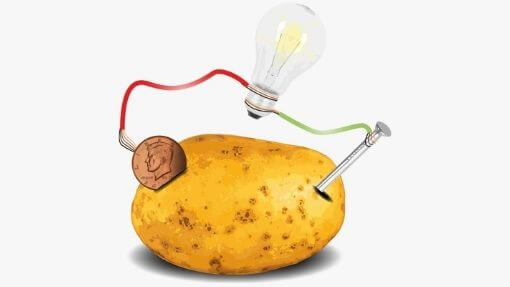A Guide to the Potato Light Bulb Experiment | Potato Power
Have you ever heard of powering a light bulb using a potato?
If you haven’t and you or your children are fascinated by the very idea, you definitely should have a go at it.
Fortunately, it’s fairly simple to do and doesn’t even require much equipment!

You can do this at home and talk your child through the science of it. So, let’s start on a guide to the potato light bulb experiment.
What You Need To Know Before You Start
A potato can only power a low-power device, such as a light bulb. It’s not going to be a way to power up a computer or charge your smartphone – at least, not in this day and age.
You don’t need to worry about the electricity being passed through the wires, as it’s extremely low voltage, so this is a safe experiment to do even at home with young children. That said, you should always supervise a science experiment in case something goes wrong!
Use insulated wires, too.
How A Potato Works As A Battery To Supply Electricity
How does it work? It seems crazy that a potato can provide electricity, but it does. A potato has acid, water, and sugar inside it, and these cause a reaction when they come into contact with certain kinds of metal.
This reaction is what gives you the power, meaning that your “potato battery” will soon run out as the reaction stops. That could take a surprising amount of time, however.
We’re an Affiliate
We hope you love the products we recommend! Just so you know, we may collect a share of sales or other compensation from the links on this page. Thank you, if you use our links, we really appreciate it!
How Do Potatoes Power A Light Bulb Or LED?
The power generated by the reaction can be wired into a light bulb or an LED.
The metals buried in the potato serve as electrodes, and within the potato, electrons will flow back and forth, generating a small current of electricity.
When wired up to a light bulb or an LED light, this small electric current is enough to light it up for a short period of time.
You will need to make a circuit so that the current can flow.
How Many Potatoes Does It Take To Light A Bulb?
If the bulb is low-power, you can theoretically light it with just one potato, but it will be dim and may not work.
To properly light a bulb up, you will probably want to use several potatoes. This will definitely be the case if you want to illuminate more power-hungry bulbs and other devices.
An LED light will often need more than one potato as well in order to give it enough power to light up properly. If you’re doing the experiment with a child, make sure you have enough potatoes at hand to avoid disappointing them.
Ways To Increase Power Output
What if you want more power? You’re going to need more potatoes and more metal! You can keep adding “potato batteries” to your experiment for as long as you like. Halving the potatoes makes it easy to stand them up and stops them from rolling away.
You might find it useful to wire your potatoes up to a voltage reader so you can see what difference adding potatoes makes. Make some notes and test whether larger and smaller pieces of potato make a difference to the readings.
Does Boiling A Potato Increase Its Energy Output?
Amazingly, boiling a potato does increase its energy output. This is because the softer tissues allow the electrons to move around more freely, and therefore reduce the loss of energy as heat.
You should boil potatoes for about ten minutes, breaking down the structures and making them softer so that the electrons can pass back and forth easily.
It’s thought that this boost to the power – coupled with other methods – could one day see potatoes as a viable electricity source… but probably not for at least a few years.
This is a great variation to include in your experiment, so put a pot of potatoes on to boil, and then test their energy output against the raw potatoes.
It’s important to log the numbers, especially if you’re undertaking the experiment with a child; they’ll get more from it if they can compare the results easily.
What You Need For The Experiment
So what do you need to have in order to do this experiment? You might be surprised that most of the things you will already have at home, or you can pick them up easily from a nearby store.
Firstly, you’ll need a potato or preferably several potatoes.
If you want to compare boiled with raw, you’ll obviously need some of both kinds.

You will also need some metal. Zinc and copper are two metals that work very effectively with potatoes, and you can use anything that is made of them.

Nails are particularly easy to push into potatoes, so if you have zinc nails, you can use those, and they will also be easy to attach the wires to.
For copper, you can use copper coins if you have any, or any other copper item that is small and can be pushed into the potato. Cut a slit in the potato if necessary.

Next, you’re going to need some copper wire. If you plan on making multiple potato batteries, you should aim to get a length of copper wire and some wire cutters, so you can make several strips.

You may want to use insulated wire; although the current should be small, it’s better to be safe, especially if doing the experiment with children.
Finally, a light bulb, LED light, and/or something to read the voltage with, and you should be ready to start!



Potato Light Bulb Guide
To make a potato battery, cut a slit in your potato and push the copper penny (or another piece of copper) in as far as you can, leaving just a small edge protruding.
Push the nail into another part of the potato. Again, you want to push it a long way in, but don’t let it touch the penny.
Ideally, you want about an inch between them, so use large potatoes.
If you’re using a multimeter to read the current, you can start by finding out how much energy your potato generates by connecting its clips to the potato’s metal protrusions.
Put the red clip on the penny and the black clip on the nail (make sure the red wire is in the + slot, the black in the – slot of the meter).
Once you have a connection, get your child to look at how much power the potato generates.
If you know the requirement of your light bulb or LED, you should now be able to work out how many potatoes will be needed to power it. Cut some more potatoes, add the coins, nails, and wire, and see if you’re correct!
Next, try the experiment with boiled potatoes, and take some guesses about how many potatoes you think will be needed. See which of you gets closer.
Your child might also be interested in measuring how long the potato battery lasts for – however, this can actually be several days. You could leave your experiment on to measure it if they are keen.
Conclusion
Making a potato battery is a great way to do a little scientific experiment with your child, or to have a bit of fun for yourself.
You don’t need a lot of equipment to do it, and there are quite a few variables you can bring to the table to make it more interesting.
Whether potatoes will one day be powering our homes remains to be seen, but there’s no doubt that the potato battery is a popular experiment in households everywhere.



